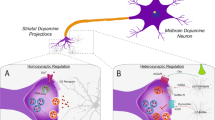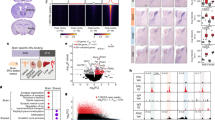Abstract
Sex matters to every cell of the body and thus gonadal steroids have the capability of affecting numerous behaviors and neurotransmitters. Several reports in this issue highlight the importance of gonadal steroids: estradiol and progesterone modulate the serotonin transporter in rodents changes in D2 receptors across the menstrual cycle in female cynomolgus monkeys testosterone influences amygdala reactivity in women and temporary suppression of gonadal steroids influences sexual in both men and women. This body of work challenges all of neuropsychopharmacology to consider the importance of sex and gonadal steroids in future studies.
Similar content being viewed by others
Main
Sex matters to every cell of the body (Wizemann and Pardue, 2001). Despite this conclusion by the IOM, the area of sex and gonadal hormones is frequently ignored in the field of neuropsychopharmacology and other basic biomedical fields. This is to a large extent because of the difficulty of parsing the roles of chromosomal sex, gonadal sex, and gonadal steroid hormones (Becker et al, 2005). Nevertheless, these are factors that are increasingly important to address, as evidenced by the articles in this issue of Neuropsychopharmacology. In this issue of Neuropsychopharmacology the importance of sex/gender differences in the brain as well as the effects of steroid hormones on brain function are examined from the perspective of psychiatric disorders, the neurological basis of sexual behavior and neurotransmitter receptor/transporter function.
Depression is more common in women, and women appear to respond better to SSRIs than men (Kornstein et al, 2000; Young et al, 2008). In addition, SSRIs are an excellent treatment for premenstrual dysphoria disorder. Thus, the report by Benmansour et al (2008) demonstrating a sex specific effect of estradiol and progesterone on function of the serotonin transporter is quite important. However, the effect is the opposite of what would be predicted from the clinical literature, further underscoring the complexity of understanding the interactions between ovarian hormones and serotonin systems. Perhaps these findings help us to better understand the vulnerability to mood disorders at times when estradiol and progesterone are high, such as the luteal phase of the menstrual cycle. Of note is the fact that these changes in response to estradiol and progesterone were not observed in hippocampi of male rats, underscoring the importance of sexual differentiation of the brain on the effects of gonadal steroids.
Studying nonhuman primates with PET imaging of D2 receptors, Czoty et al (2008) found that [18F]FCP binding sites showed a greater availability in the caudate and putamen during the luteal phase, suggesting more unoccupied receptors during this menstrual cycle phase. Although the changes might be due to increased numbers of receptors, the use of a ligand displaceable by endogenous DA suggests the alternative possibility that higher receptor availability reflects decreased DA release during this phase. Of note, the follicular phase scans were conducted on day 9 of the follicular phase when estradiol levels should still be low, whereas the luteal scans (days 21–26) may have occurred during high estradiol phases in some animals. Studies have found that high physiological doses of estradiol enhance the release of DA (Becker et al, 2001) and decrease D2 DA receptor binding (Becker, 1999) in female rodents. In women, the subjective effects of drugs of abuse are enhanced during the follicular phase relative to the luteal phase and progesterone is found to attenuate the subjective response to drugs like cocaine and nicotine (Becker and Hu, 2008). Taken together, we see again the complexity of understanding the effects of menstrual cycle phase on DA neurotransmission, but the importance of these studies for the clinical condition.
Finally, two papers focus on behavioral effects of gonadal steroids: one on amygdala reactivity and another on sexual functioning. The study by van Wingen et al (2008) is based on animal studies that testosterone regulates activity in the amygdala of male and female rodents. They report that there is an age-related decline in serum testosterone as well as in amygdala reactivity in women. Using a placebo-controlled design they administered testosterone to older women and reexamined the effect on amygdala reactivity and found that testosterone reliably increased the amygdala response to faces. It also increased neural activity in response to faces in several brain regions including inferior frontal and middle temporal gyri, suggesting widespread modulation of neural activity. The timeframe of these actions was short (30 min) but, as with all experiments utilizing testosterone, we do not know for sure that these actions are through the androgen receptor vs conversion of testosterone by aromatase intracellularly in the amygdala to estradiol. It is possible, therefore, that these effects are mediated by estradiol acting at estrogen receptors. Nonetheless, it provides interesting new leads to think about the role of sex steroids in gender differences in anxiety and depression and changing rates across the reproductive life course of women.
The report by Schmidt et al (2008) examines data from their studies examining gonadal suppression and subsequent hormone replacement on aspects of sexual functioning in men and women. The effects of gonadal suppression were sex specific. In men, sexual function was reduced by gonadal suppression and restored by testosterone. In women, the gonadal suppression did change the quality of orgasm, but this effect was not reversed by replacement with either estradiol or progesterone alone. Unfortunately, as acknowledged by the authors, gonadal suppression also lowered testosterone in women and there was no testosterone replacement, nor any combination of sex steroids, which would approach the normal hormonal milieu of women. Still, this is an interesting report pointing to sex differences in the effects of sex steroid suppression in men vs women on normal sexual function.
All these authors are to be congratulated on these studies examining sex differences and the important role of gonadal steroid hormones.
References
Becker JB (1999). Gender differences in dopaminergic function in striatum and nucleus accumbens. Pharmacol Biochem Behav 64: 803–812.
Becker JB, Arnold A, Berkeley KJ, Blaustein JD, Eckel LA, Hampson E et al (2005). Strategies and methods for research on sex differences in brain and behavior. Endocrinology 146: 1650–1673.
Becker JB, Hu M (2008). Sex differences in drug abuse. Front Neuroendocrinol 29: 36–47.
Becker JB, Molenda H, Hummer DL (2001). Gender differences in the behavioral responses to cocaine and amphetamine. Implications for mechanisms mediating gender differences in drug abuse. Ann NY Acad Sci 937: 172–187.
Benmansour S, Piotrowski JP, Altamirano AV, Frazer A (2008). Impact of ovarian hormones on the modulation of the serotonin transporter by fluvoxamine. Neuropsychopharmacology 34: 555–564.
Czoty PW, Riddick NV, Gage HD, Sandridge M, Nader SH, Garg S et al (2008). Effect of menstrual cycle phase on dopamine d2 receptor availability in female cynomolgus monkeys. Neuropsychopharmacology 34: 548–554.
Kornstein SG, Schatzberg AF, Thase ME, Yonkers KA, McCullough JP, Keitner GI et al (2000). Gender differences in treatment response to sertraline versus imipramine in chronic depression. Am J Psychiatry 157: 1445–1452.
Schmidt PJ, Steinberg EM, Negro PP, Haq N, Gibson C, Rubinow DR (2008). Pharmacologically induced hypogonadism and sexual function in healthy young women and men. Neuropsychopharmacology 34: 565–576.
van Wingen GA, Zylicz SA, Pieters S, Mattern C, Verkes RJ, Buitelaar JK et al (2008). Testosterone increases amygdala reactivity in middle-aged women to a young adulthood level. Neuropsychopharmacology 34: 539–547.
Wizemann TM, Pardue ML (2001). Exploring the Biological Contributions to Human Health: Does Sex Matter? Board on Health Sciences Policy, Institute of Medicine: Washington, DC.
Young EA, Kornstein SG, Marcus SM, Harvey AT, Warden D, Wisniewski SR et al (2008). Sex differences in response to citalopram: a STAR *D report. J Psychiatr Res; [e-pub ahead of print].
Author information
Authors and Affiliations
Corresponding author
Additional information
DISCLOSURE/CONFLICT OF INTEREST
Both Dr Young and Dr Becker receive support for their research from NIH. Elizabeth Young also receives research support from the Pritzker Foundation. Becker receives support from Pfizer Inc. Neither have patents or stock holdings to declare.
Rights and permissions
About this article
Cite this article
Young, E., Becker, J. Perspective: Sex Matters: Gonadal Steroids and the Brain. Neuropsychopharmacol 34, 537–538 (2009). https://doi.org/10.1038/npp.2008.221
Received:
Accepted:
Published:
Issue Date:
DOI: https://doi.org/10.1038/npp.2008.221



